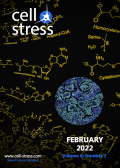Table of contents
Volume 6, Issue 2, pp. 17 - 29, February 2022
Cover: This month in
Cell Stress: The transsulfuration pathway in neuroblastoma. Image depicts a histological section of adrenal gland neuroblastoma. Image credit: Ed Uthman from Houston, TX, USA, via Wikimedia Commons
CC BY 2.0 license. Background chemical pathway by Hbf878 via Wikimedia Commons,
CC0 1.0 license. Image modified by
Cell Stress. The cover is published under the
CC BY 4.0 license.
Enlarge issue cover
Building and breaking the gut barrier with bariatric surgery
Mohammed K. Hankir
News and thoughts |
page 17-20 | 10.15698/cst2022.02.263 | Full text | PDF |
Abstract
Bariatric surgery has been proposed to improve glycemic control in morbidly obese patients by stabilising the gut barrier and alleviating endotoxemia-induced insulin resistance. Here, recent studies are highlighted which reveal site-specific and at times opposing effects of bariatric surgery on the gut barrier. Further understanding the underlying mechanisms may not only inform the development of novel gut-based drugs for the initial treatment of type 2 diabetes, but possibly also assist in the management of its eventual relapse.
MYCN upregulates the transsulfuration pathway to suppress the ferroptotic vulnerability in MYCN-amplified neuroblastoma
Konstantinos V. Floros, Ayesha T. Chawla, Mia O. Johnson-Berro, Rishabh Khatri, Angeliki M. Stamatouli, Sosipatros A. Boikos, Mikhail G. Dozmorov, L. Ashley Cowart and Anthony C. Faber
Research Reports |
page 21-29 | 10.15698/cst2022.02.264 | Full text | PDF |
Abstract
Ferroptosis is an iron-dependent, oxidative form of cell death that is countered mainly by glutathione peroxidase 4 (GPX4) and the production of glutathione (GSH), which is formed from cysteine. The identification of the cancers that may benefit from pharmacological ferroptotic induction is just emerging. We recently demonstrated that inducing ferroptosis genetically or pharmacologically in MYCN-amplified neuroblastoma (NB) is a novel and effective way to kill these cells. MYCN increases iron metabolism and subsequent hydroxyl radicals through increased expression of the transferrin receptor 1 (TfR1) and low levels of the ferroportin receptor. To counter increased hydroxyl radicals, MYCN binds to the promoter of SLC3A2 (solute carrier family 3 member 2). SLC3A2 is a subunit of system Xc-, which is the cysteine-glutamate antiporter that exports glutamate and imports cystine. Cystine is converted to cysteine intracellularly. Here, we investigated other ways MYCN may increase cysteine levels. By performing metabolomics in a syngeneic NB cell line either expressing MYCN or GFP, we demonstrate that the transsulfuration pathway is activated by MYCN. Furthermore, we demonstrate that MYCN-amplified NB cell lines and tumors have higher levels of cystathionine beta-synthase (CBS), the rate-limiting enzyme in transsulfuration, which leads to higher levels of the thioether cystathionine (R-S-(2-amino-2-carboxyethyl)-l-homocysteine). In addition, MYCN-amplified NB tumors have high levels of methylthioadenosine phosphorylase (MTAP), an enzyme that helps salvage methionine following polyamine metabolism. MYCN directly binds to the promoter of MTAP. We propose that MYCN orchestrates both enhanced cystine uptake and enhanced activity of the transsulfuration pathway to counteract increased reactive oxygen species (ROS) from iron-induced Fenton reactions, ultimately contributing to a ferroptosis vulnerability in MYCN-amplified neuroblastoma.



